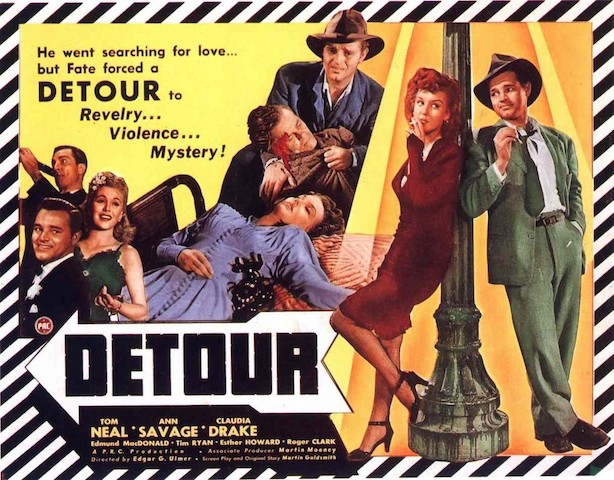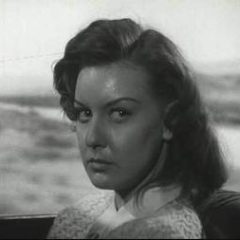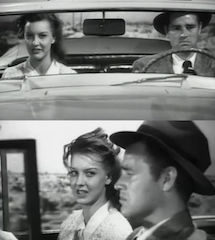
Director: Edgar G. Ulmer
Written by Martin Goldsmith (and Martin Mooney, uncredited)
Music by Leo Erdody
Cinematography by Benjamin H. Kline
CAST
Tom Neal as Al Roberts
Ann Savage as Vera
Claudia Drake as Sue Harvey
Edmund MacDonald as Charles Haskell Jr.
Tim Ryan as Nevada Diner Proprietor
Esther Howard as Diner Waitress
Pat Gleason as Joe
![Detour (1945) [Film Noir] [Drama]](https://i.ytimg.com/vi/tap67KjjPu8/hqdefault.jpg)
Detour is a masterpiece of wry perversity, a film virtually constructed on irony and paradox: an incredibly claustrophobic film about hitchhiking on the “open road”; the bleakest of films noirs, with the bulk of the action taking place during the day and away from the city. But perhaps the supreme ironies relate to the film itself. Despite acting that ranges from incompetent to bizarre, a storyline bordering on the absurd—alternately trashy and fanciful—and a minimum of sets or characters, Detour somehow speaks directly and compellingly to the dark side of several pervasive American myths, forcefully expresses a coherent vision of the way the world operates.
But if Detour can reward the receptive filmgoer, it does, by its very nature, demand a little more than the ordinary film. After all, there is no denying that a film shot in a very short time (rumored to have been four days, more likely five or six), on a budget of—it almost seems—something in the neighborhood of 45 cents, may lack some of the slickness and polish we ordinarily expect. But if we focus on what the film offers rather than what it lacks, we can begin to appreciate what is, on reflection, an extraordinary piece of filmmaking.
To understand Detour‘s wry perversity, it may be necessary to know something of the man who made it, Edgar G. Ulmer: an extraordinarily gifted German who began his career working with people like Lang and Murnau, and himself made films in Hollywood for over 30 years. Yet the biggest “star” he ever directed was Zachary Scott and his longest shooting schedule was 12 days, with most of his films made even more quickly. He deliberately refused to work for any major studio, preferring the complete creative freedom and low budgets of Poverty Row. The “freedom” he found there enabled him to direct Yiddish-language pictures, a Ukrainian musical, a Harlem movie, and a prison film called Women in Chains. Ulmer may have been able to make such films exactly as he wanted, but with such dubious projects, with budgets so small many scenes were done in one take, his freedom often must have seemed as illusory as that of Detour‘s hitchhiker. …
When we discuss the conditions of Ulmer’s career, the necessity for choosing between “selling out” to a major studio or working on Poverty Row, we can easily see how he might have felt a personal affinity for a project like Detour. It is no accident that the hitchhiker’s intended destination should be Hollywood where he will find success and happiness. (There is even one shot in which two characters are framed in a window that looks for all the world exactly like a movie screen.) After a decade of Jive Junctions and Women in Chains, of limited options and illusory freedom, of entrapment within the economic imperatives of Hollywood, Ulmer was exceedingly well-equipped to handle Detour‘s desperate fatalism. The film’s grim acceptance of a malignant fate, its deliberate mockery of some of the more facile American myths, its singular admixture of the banal and the bizarre surely reflect the director’s belief in the existence of the illusion of free choice, not the substance of free will. It is hardly surprising that he made of this project perhaps the finest of his ten-day wonders, a forceful and compelling articulation of a distinctive world-view.
***

Claudia Drake as Sue Harvey sings ‘I Can’t Believe You’re In Love With Me’ in Detour
***
‘No one who has seen it has easily forgotten it…’
Detour: ***** by Roger Ebet, June 7, 1998
Detour is a movie so filled with imperfections that it would not earn the director a passing grade in film school. This movie from Hollywood’s poverty row, shot in six days, filled with technical errors and ham-handed narrative, starring a man who can only pout and a woman who can only sneer, should have faded from sight soon after it was released in 1945. And yet it lives on, haunting and creepy, an embodiment of the guilty soul of film noir. No one who has seen it has easily forgotten it.
Detour is a movie so filled with imperfections that it would not earn the director a passing grade in film school. This movie from Hollywood’s poverty row, shot in six days, filled with technical errors and ham-handed narrative, starring a man who can only pout and a woman who can only sneer, should have faded from sight soon after it was released in 1945. And yet it lives on, haunting and creepy, an embodiment of the guilty soul of film noir. No one who has seen it has easily forgotten it.

Tom Neal as Al Roberts
Detour tells the story of Al Roberts, played by Tom Neal as a petulant loser with haunted eyes and a weak mouth, who plays piano in a nightclub and is in love, or says he is, with a singer named Sue. Their song, significantly, is “I Can’t Believe You Fell in Love With Me.” He wants to get married, she leaves for the West Coast, he continues to play piano, but then: “When this drunk gave me a ten spot, I couldn’t get very excited. What was it? A piece of paper crawling with germs.”
So he hitchhikes to California, getting a lift in Arizona from a man named Haskell, who tells him about a woman hitchhiker who left deep scratches on his hand: “There oughta be a law against dames with claws.” Haskell dies of a heart attack. Al buries the body, and takes Haskell’s car, clothes, money and identification; he claims to have no choice, because the police will in any event assume he murdered the man.
He picks up a hitchhiker named Vera (Ann Savage), who “looked like she’d just been thrown off the crummiest freight train in the world.” She seems to doze, then sits bolt upright and makes a sudden verbal attack: “Where’d you leave his body? Where did you leave the owner of this car? Your name’s not Haskell!” Al realizes he has picked up the dame with the claws.
Haskell had told them both the same unlikely story, about running away from home at 15 after putting a friend’s eye out in a duel (“My dad had a couple of FrancoPrussian sabers”).

Ann Savage as Vera
In Los Angeles, Vera reads that Haskell’s rich father is dying, and dreams up a con for Al to impersonate the long-lost son and inherit the estate. Waiting for the old man to die, they sit in a rented room, drinking, playing cards and fighting, until Al finds himself with another corpse on his hands, once again in a situation that makes him look guilty of murder.
Roberts is played by Tom Neal as a sad sack who seems relieved to surrender to Vera (“My favorite sport is being kept prisoner”). Ann Savage plays Vera as a venomous castrator. Every line is acid and angry; in an era before four-letter words, she lashes Al with “sucker” and “sap.” Of course Al could simply escape from her. Sure, she has the key to the room, but any woman who kills a bottle of booze in a night can be dodged fairly easily. Al stays because he wants to stay. He wallows in mistreatment.
The movie was shot on the cheap with B-minus actors, but it was directed by a man of qualities: Edgar G. Ulmer (1900-1972), a refugee from Hitler, who was an assistant to the great Murnau on The Last Laugh and Sunrise, and provided one of the links between German Expressionism, with its exaggerated lighting, camera angles and dramaturgy, and the American film noir, which added jazz and guilt. …
Most critics of Detour have taken Al’s story at face value: He was unlucky in love, he lost the good girl and was savaged by the bad girl, he was an innocent bystander who looked guilty even to himself. But the critic Andrew Britton argues a more intriguing theory in Ian Cameron’s Book of Film Noir. He emphasizes that the narration is addressed directly to us: We’re not hearing what happened, but what Al Roberts wants us to believe happened. It’s a “spurious but flattering account,” he writes, pointing out that Sue the singer hardly fits Al’s description of her, that Al is less in love than in need of her paycheck, and that his cover-up of Haskell’s death is a rationalization for an easy theft. For Britton, Al’s version illustrates Freud’s theory that traumatic experiences can be reworked into fantasies that are easier to live with.
 Maybe that’s why Detour insinuates itself so well–why audiences respond so strongly. The jumps and inconsistencies of the narrative are nightmare psychology; Al’s not telling a story, but scurrying through the raw materials, assembling an alibi. Consider the sequence where Al buries Haskell’s body and takes his identity. Immediately after, Al checks into a motel, goes to sleep, and dreams of the very same events: It’s a flashback side-by-side with the events it flashes back to, as if his dream mind is doing a quick rewrite. …
Maybe that’s why Detour insinuates itself so well–why audiences respond so strongly. The jumps and inconsistencies of the narrative are nightmare psychology; Al’s not telling a story, but scurrying through the raw materials, assembling an alibi. Consider the sequence where Al buries Haskell’s body and takes his identity. Immediately after, Al checks into a motel, goes to sleep, and dreams of the very same events: It’s a flashback side-by-side with the events it flashes back to, as if his dream mind is doing a quick rewrite. …
The movie’s low budget is obvious. During one early scene, Ulmer uses thick fog to substitute for New York streets. He shoots as many scenes as possible in the front seats of cars, with shabby rear-projection (the only meal Al and Vera have together is in a drive-in). For a flashback, he simply zooms in on Neal’s face, cuts the lights in the background, and shines a light in his eyes.
Sometimes you can see him stretching to make ends meet. When Al calls long-distance to Sue, for example, Ulmer pads his running time by editing in stock footage of telephone wires and switchboard operators but can’t spring for any footage of Sue actually speaking into the phone (Al does all the talking, and then Ulmer cuts to her lamely holding the receiver to her ear).
And it’s strange that the first vehicles to give lifts to the hitchhiking Al seem to have right-hand drives. He gets in on what would be the American driver’s side, and the cars drive off on the “wrong” side of the road. Was the movie shot in England? Not at all. My guess is that the negative was flipped. Ulmer possibly shot the scenes with the cars going from left to right, then reflected that for a journey from the east to the west coasts, right to left would be more conventional film grammar. Placing style above common sense is completely consistent with Ulmer’s approach throughout the film.
Do these limitations and stylistic transgressions hurt the film? No. They are the film. Detour is an example of material finding the appropriate form. Two bottom-feeders from the swamps of pulp swim through the murk of low-budget noir and are caught gasping in Ulmer’s net. They deserve one another. At the end, Al is still complaining: “Fate, for some mysterious force, can put the finger on you or me, for no good reason at all.” Oh, it has a reason.
Follow this link to Roger Ebert’s full review, posted at his website on June 7, 1998
***
Selected Short Subject: Brotherhood of Man (1946)
Director: Robert Cannon
Screenplay by Ring Lardner Jr., John Hubley, Phil Eastman
Animation: Robert Cannon, Ken Harris, Ben Washaw

Brotherhood of Man was largely created by Warner Bros. staffers–Ken Harris and Ben Washam were currently animators for Chuck Jones, Paul Julian was a background artist for Friz Freleng and director Bobe Cannon had very recently been a Jones animator–but this film doesn’t look anything like a Looney Tunes short. John Hubley largely designed the cartoon, and he gave the characters a flat, pointed look that really had no precedent in Hollywood animation. The visual style seems patterned after New Yorker cartoonist Saul Steinberg, and the short was one of the first big steps towards the modernized look UPA (United Production of America) would spearhead in the early 1950s.
The background designs are equally innovative, with lots of flat patches of color and objects like cars and airplanes depicted in see-through line drawings. Hubley and Cannon hadn’t yet found a way to stylize characters’ movements as well as their designs, and–other than a heavy use of static images–the animation here is mostly similar to other Hollywood cartoons produced around this time (John Hubley’s U.S. Navy training film Flat Hatting, also released in 1946, shows a more creative approach to movement). That being said, Brotherhood of Man is still an extremely bold foray into a totally new look.
The film’s subject matter is equally bold. The short, which was based off of a pamphlet entitled Races of Mankind (written by Ruth Benedict and Gene Weltfish) and adapted for the screen by Hubley, Ring Lardner Jr. and Phil Eastman, is an educational film that calls for racial harmony and explains how there are no major differences between the races. The short cleverly depicts suspicion and contempt for other races in the form of little green men who act as shoulder devils on otherwise ordinary citizens. The film is entertaining without being overly preachy, and everything the narrator says feels like basic common sense. It may not have seemed that way in 1946, when racial prejudices of many kinds were still quite prevalent. This short is a daring and inventive work that also has something to say.
(Source: Forces of Geek, April 9, 2015, by Steven Blitz)



